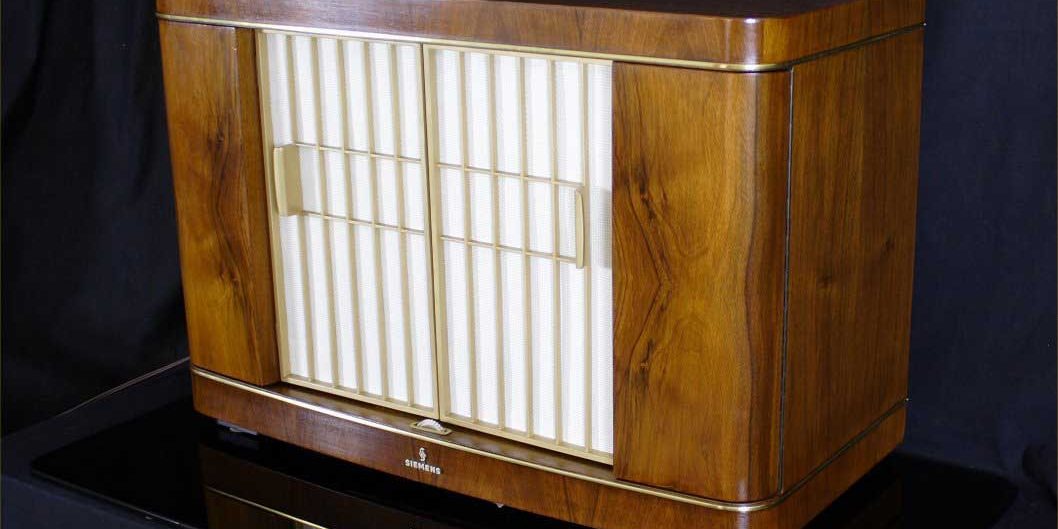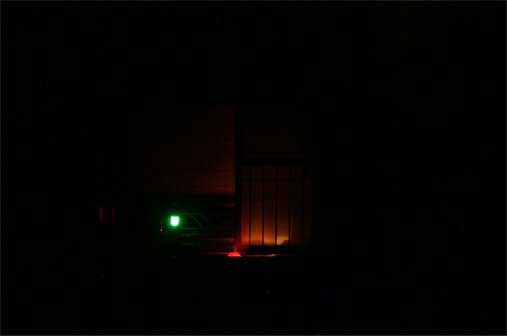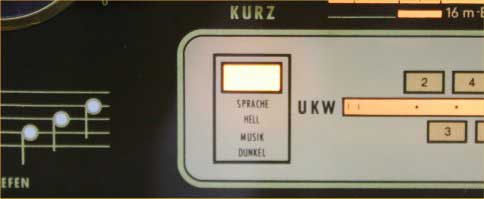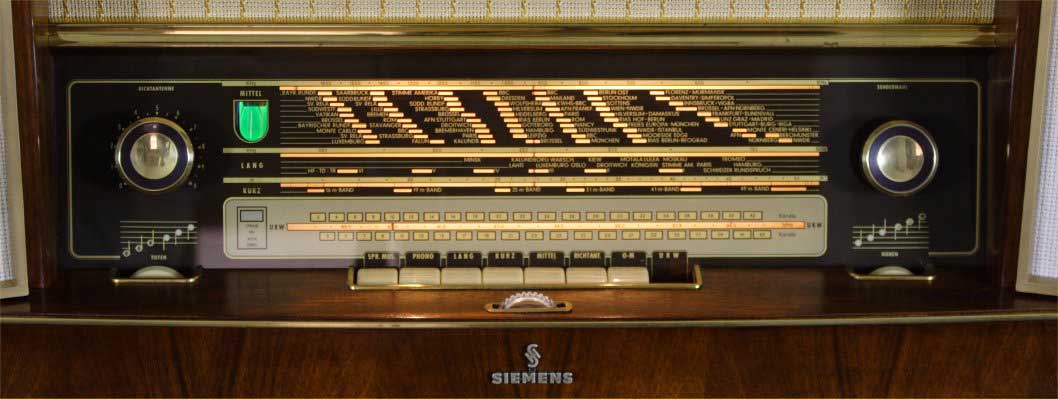 german radios - en
german radios - en
Siemens Schatulle M57 – en
- by giovanni
Siemens Schatulle M57
SIEMENS SCHATULLE M57
The Siemens Schatulle was produced between 1955 and 1957 and it was of the best and most successful models of the entire Schatulle series. Although the number of sold items was smaller if compared to the smaller and cheaper H42 and although it was not as huge and well-sounding as the P48, this was certainly the most well-balanced model under many aspects.
Further on I will explain why.
- The power stage is as big as the P48’s, a couple of Push-Pull EL84, a sophisticated counterreaction system, physiological volume control, separated high- and bass controls
- it is equipped with 4 loudspeakers. Differently from the P48, the M57 is equipped with two bicone widebands and two tweeters with acustic drive. That makes the reproduction particularly refined and linear.
- Its dimension are midway between the H42 and the P48 making the M57 easy to place and at the same time majestic. Moreover the length/height ration makes the appearance of this device extremely pleasant although being rather big.
- Differently from other models, this device can be turned on and off and the volume can be regulated even when the small front shutters are closed.
None of the other Schatulle models is characterized by these elements. This is the reason why the Schatulle M57 belongs to the top quality Siemens production.
This device is best to be listened in on in a spacious room and played out loud.
The tuning stability allows the last station to be perfectly centered after days.
The mechanics is “simple” but robust. The electronic parts are rather complex, but completely restored.
Other features will be further described down below.
The finest sound you can hear from a Siemens

-
BLUETOOTH
Bluetooth receiver embed -
MULTI PLATFORM CONNECTION
Each radio is equipped with a cable for connection to any digital device.
TUBESOUND IMPROVEMENT
- Bluetooth receiver embed - The unit is equipped with a BLUETOOTH receiver powered directly by the receiver power supply. This makes it possible to control the amplifier from any external digital device as an IPAD, a Smartphone, or a sophisticated multimedia station. So you can hear your preferred web station or your lossesless file without cables on the room. Wireless Receiver can be equipped upon requests.
- Multi Platform Connection - A customized adaptation cable to connect any digital device as Iphone, Smartphone, Laptop, CD Player etc. will be provided with this radio. This special cable suits the different impedances between the modern equipment and the receiver. Furthermore the two stereo channels flow into one without increasing the load to the input unit.
MAIN FEATURES
Year of production: 1955/1957
9 AM Circuits
14 FM Circuits
Wavebands:
Medium Waves(OM), Long Waves(OL), Short waves(OC), FM(UKW)
Power supply: (AC)
110; 125; 160; 220 Volt
two 8" dual cone wideband
two 4" cone tweeters
Dimensions (LHD): 27 x 18.3 x 13 inch
Net weight: 42 lb 15.2 oz
Tubes 11: EC92 EC92 EF89 ECH81 EM80 EF89 EF80 EABC80 ECC83 EL84 EL84

TONE CONTROL WITH LEVEL INDICATION
The tones control system is very efficient. Above the large tone control knobs there is a band that lights up gradually indicating the emphasis on the band on which it acts.
AERIALS
Inside the cabinet there is a dipole for FM reception and a ferrite rotating aerial for AM reception.
Ferrite aerial can be rotated from the outside to achieve a perfect tuning of the device in the AM.
In this picture see the rotation mechanism and the position indicator of the aerial.
The reception sensitivity with internal aerials is very good. This unit was in fact produced in a period when there were not many radio stations and those available fairly apart from each others.
Using an external aerial sensitivity is further increased.


SEPARATE CONTROL TUNING BETWEEN AM AND FM
The tuning system is another gem.
The unit is equipped with mechanisms for keeping separate the AM bands by the FM bands.
The tuning knob is single but a selector switch commutes into cable systems (all in steel) and pulleys separated depending on the band.
PECULIARITIES
The knob outside the shutters has a double function:
- On/off button (push)
- Volume control (turn)
You can therefore easily avoid to open the shutters to control the device.
The outer knob glows red when the radio is turned on.
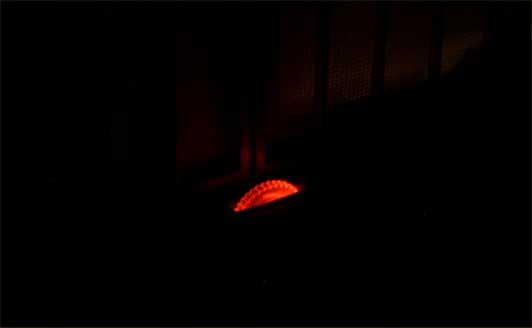
The shutters’ cladding canvas needs to be acoustically as transparent as possible. It is a robust but holed canvas in order for the light to go through.
If you closed the shutter when the radio is on the effect created by the visible rear lights would be rather unpleasant.
Siemens solved this:
- When you close the left shutter the magic eye turns off automatically
- When you close the right shutter the lightning of the dial scale switches off
TUNING INDICATOR
The magic eye has of course been replaced.
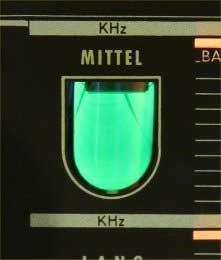
LOUDSPEAKERS
There are four louspeakers.
Two 21 cm (8.2 inches) very efficient bicone and known by experts using these louspeakers to create amplifiers.
The radio is equipped with two cone tweeters assembled on the acoustic lens.
That creates a pleasant ambience and a side diffusion as widespread as possible.
The controls are placed in an unusual way.
On the left there is the rotation control of the ferrite curve.
On the right you can see the magic eye indicating the perfect tuning of each station.
Below the magic eye you can see the equalizer indicator Sprache/Musik above mentioned.
Then the Short, Medium and Long Waves AM scale is to be found together with the differently colored FM scale.
Lastly you can see the tuning knob, whose two supporting big fly-wheels make its movement very pleasant.
Below you can find the bass control knob.
In order then: the Sprache/Musik, record player, Long, Short and Medium Waves, ferrite curve, OM narrow band and FM commutation buttons.
Lastly, on the right, the acute control knob.
The illuminated small knob outside the shutters allows the volume control (with incorporated loudness)

REAR SIDE
Output for external speakers.
Socket for recorder (tonbandgerat).
Turntable input (Tonabnehmer)
AM and FM aerial inputs and ground socket.






